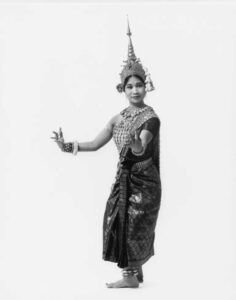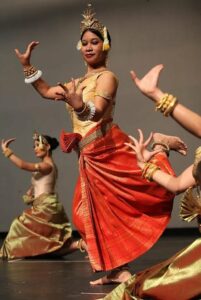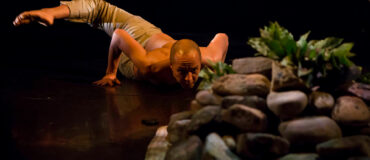By Lingyu Wang
Lingyu Wang is a 2022 Archiving and Preservation Fellow with Charya Burt Cambodian Dance. Read more about the Fellowships here. This is the second part of Lingyu’s blog. Read the first part here.
September 23, 2022: Wrangling with Technology

Charya in the female (Neang) character in a Cambodian classical dance costume, 1997 Photo by Marty Sohl
Please allow me to show you a small part of what I learned in the past weeks, since the last blog post about my work on the Charya Burt Cambodian Dance Digital Library: Surprise, the detailed type tags are not doing much; Surprise, the database’s shared views do not let us link one table with another; Surprise, there are implicit rules in the system that will not allow us to add a new record a certain way; Surprise, it turns out the most user-friendly options are only for maintenance interfaces, not the public-facing ones.
It is probably fair to say that most updates over the past weeks are about us wrangling with some limitations of the technical infrastructure, namely the Airtable database. To be clear, it is still a quite user-friendly and responsive system compared to big ones like FileMaker, but we have also fast approached the point where we feel systemic rules rubbing against the way we hope to curate our dance archive.
One such example is the problem with record filing. At the beginning, I noticed that many materials in Charya’s dance library can belong to multiple collections. In one video, Charya Burt and one of her apprentices were demonstrating Robam Apsara, a classical dance piece. This video can be filed to both an instructional video series and the Robam Apsara classical repertory collection. In fact, it probably should belong to both, as many of Charya’s works are not just serving one project, one purpose. And luckily, Airtable allows us to do that. So initially, we planned to build a more rhizomatic system where records and collections can more liberally link with each other. After all, digital archives have this extra flexibility over physical documents. We can file one digital record into many collections, but we cannot have one physical video tape in multiple boxes at the same time (well, to be precise we can, but that will involve a much more complex proxy system).

Charya with dancers Julie Nuth and Chankethya Chey performing at the premiere of her Blossoming Antiquities: Rodin’s Encounter with the Celestial Dancers of Cambodia at the San Francisco Legion of Honor Museum Theatre, 2013 – San Francisco Chronicle – Photo by Liz Hafalia
While we can make those connections in the backend, it turns out Airtable’s frontend options are not designed for this kind of structure. As soon as we share the library through Airtable’s publicly-accessible shared views, all of that interconnected structure is lost. Someone from the general public can only see individual tables—one for records, one for collections, one for places, etc.—and those tables are separated from each other. The public cannot click into the connections that we build in the backend, unless we choose to publish the entire library and give up any control over who can see what materials, or go with some expensive and hard-to-maintain third-party expansions. Realistically, it seems that the only way we can preserve some public usability is to compromise the structure. We have to go back to the one-record-in-one-place kind of hierarchy, so that just within the table of all records, using built-in functions, we can group records based on what collections they belong to. The database software gave us the ability to create all those connections, but it did not give us the ability to share and make good use of them.
That said, we had made some significant progress as well. We were able to build a Cambodian dance vocabulary, a user manual, and a detailed guided form for adding new records right in the library. These are both informative resources for public users and important tools for Charya and Rob, since they will be maintaining the library after my fellowship is over. Interfaces like the guided form combine written documentations with functional interactive tools, so that an untrained person can still follow along the instructions while handling the actual archive. Interfaces as documentation of how the archive works may be more useful and important than I initially expected, so I will probably discuss them in detail next time.
Top image: Charya Burt leading a community engagement workshop with the Wat Khmer Modesto Dance Group. Photo by Rob Burt. All photos courtesy of Charya Burt Cambodian Dance.
 Lingyu Wang (he/they) is a doctoral student in the School of Information and Library Science at University of North Carolina at Chapel Hill. His ongoing research looks at social movement archiving in Hong Kong, Mainland China, and beyond. He received a B.A. in Film and a B.S. in Computer Science from University of California, Berkeley, as well as a M.A. in Media, Culture, and Communication from New York University. Previously, he worked at the Media Resources Center at UC Berkeley, and served as graduate assistant at NYU Libraries’ Scholarly Communications Office. He has also extensively worked in film and stage productions.
Lingyu Wang (he/they) is a doctoral student in the School of Information and Library Science at University of North Carolina at Chapel Hill. His ongoing research looks at social movement archiving in Hong Kong, Mainland China, and beyond. He received a B.A. in Film and a B.S. in Computer Science from University of California, Berkeley, as well as a M.A. in Media, Culture, and Communication from New York University. Previously, he worked at the Media Resources Center at UC Berkeley, and served as graduate assistant at NYU Libraries’ Scholarly Communications Office. He has also extensively worked in film and stage productions.
Recent social movements across the globe have propelled Lingyu to study creative, performative forms of activism; people use these highly affective forms to resist erasure and build communities. Lingyu is thus drawn to Charya Burt, whose dances use a rich repertoire of mediums and techniques to discuss similar memories and histories. Together with Charya and her colleagues, he looks forward to pushing the archives’ boundaries to tell better stories and connect people with shared pasts.
____
We accept submissions on topics relevant to the field: advocacy, artistic issues, arts policy, community building, development, employment, engagement, touring, and other topics that deal with the business of dance. We cannot publish criticism, single-company season announcements, and single-company or single artist profiles. Additionally, we welcome feedback on articles. If you have a topic that you would like to see addressed or feedback, please contact communications@danceusa.org.
Disclaimer: Opinions expressed in guest posts do not necessarily represent the viewpoints of Dance/USA.




